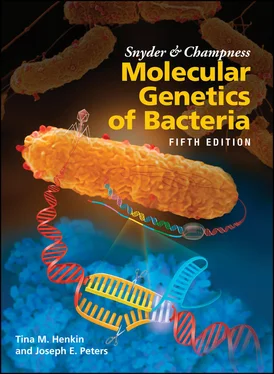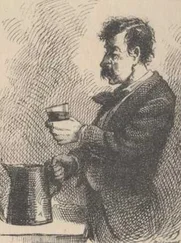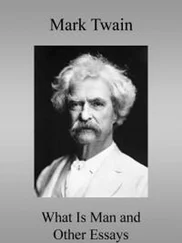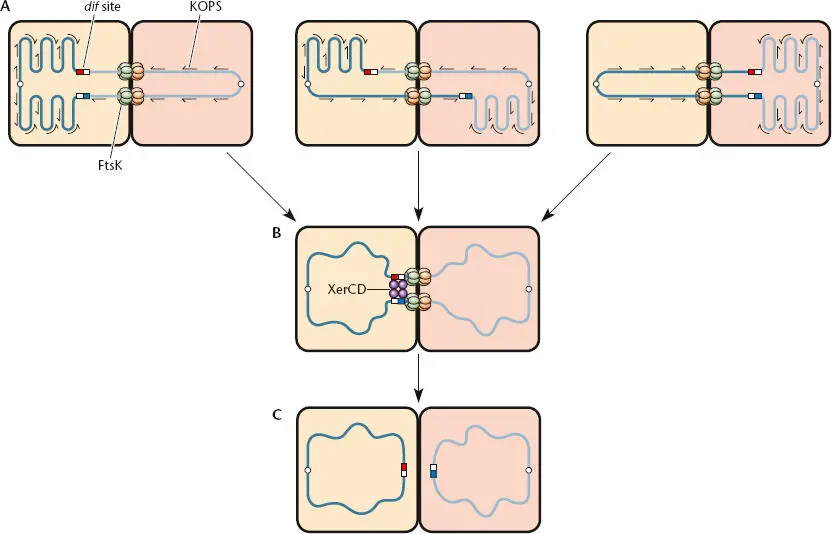
Figure 1.17 Model of the way in which chromosome translocation by FtsK coordinates chromosome segregation with dimer resolution. The two daughter chromosomes in a dimerized chromosome are shown in different shades of blue for emphasis. (A)Three possible distributions of the newly replicated dimer chromosome are shown following the start of cell septation. FtsK is a DNA translocase that can pump the chromosomes to the correct daughter cells using polar sequences in the chromosome called KOPS sites (shown as half arrows) while also moving the dif sites into alignment at the septum. Green indicates FtsK complexes that are actively pumping; orange indicates idle FtsK complexes where activity is set by the orientation of KOPS sites. (B)After aligning the dif sites, the FtsK protein also interacts with the XerCD enzyme, allowing it to resolve the dimer chromosomes at the dif sites. (C)The coordinated activities of the dimer resolution system and FtsK lead to monomer chromosomes that are capable of full segregation to daughter cells. From Camara JE, Crooke E, in Higgins NP (ed), The Bacterial Chromosome (ASM Press, Washington, DC, 2005).
Homologs of FtsK are widespread, and a homologous protein called SftA appears to carry out similar functions in B. subtilis (see Biller and Burkholder, Suggested Reading). Some bacteria have more than one FtsK-like protein, presumably for other specialized tasks. In the case of B. subtilis , another FtsK homolog, SpoIIIE, is responsible for translocating the final third of the chromosome into spores during spore development so the spore will get a complete copy of the chromosome (see chapter 12). How the roles of FtsK, SpoIIIE, and SftA differ and how the multiple members are involved in various DNA processing events in a single cell remain active areas of research with many questions still to be answered.
Interestingly, instead of XerC and XerD, Streptococcus and Lactococcus species have a system more closely related to bacteriophage integration systems that uses a single protein called XerS to carry out the same function (see Le Bourgeois et al., Suggested Reading). Archaea also seem to use a single protein (in this case called XerA) to resolve dimer chromosome at a cis -acting dif site (see Cortez et al., Suggested Reading). The regulation of dimer chromosome resolution in these systems and any involvement of FtsK-like proteins are unclear.
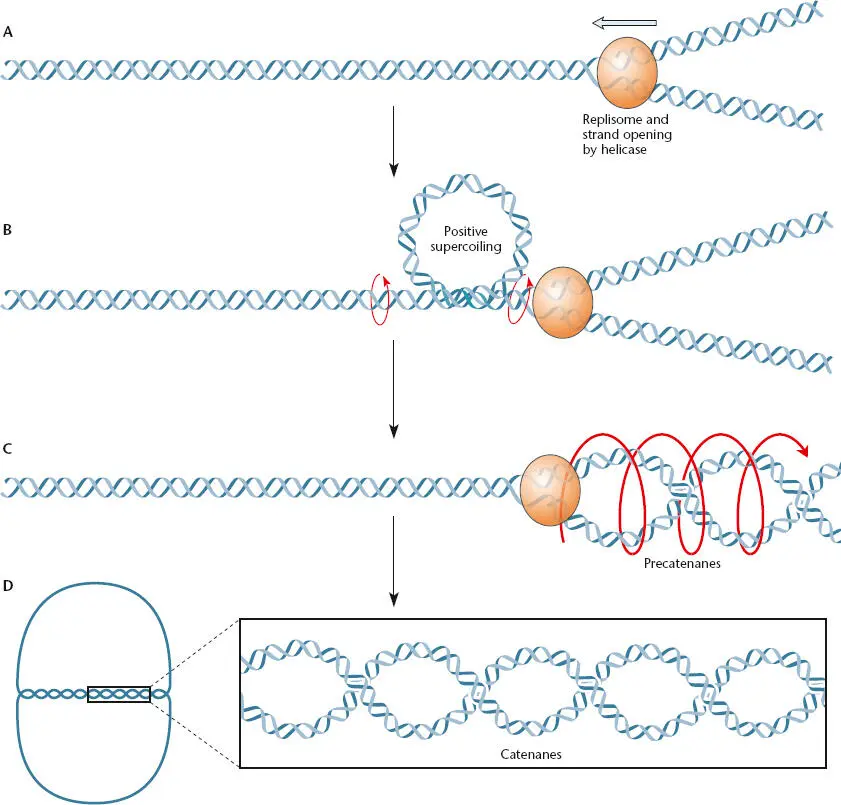
Figure 1.18 Model of the way in which unwinding of the template DNA strands can cause twists that can diffuse across the replication complex and twist the new DNA strands. (A)The replication machinery must open the double-stranded DNA to copy the template strands. (B)Unwinding the template DNA strands introduces twists (shown by thin red arrows) called positive supercoils ahead of the replication fork. (C)Some of the torsion that is generated ahead of the replication fork can be relieved by rotation of the replication complex itself. The torsional stress can spread behind the fork and intertwine the new copies of the chromosome (shown by a thick red arrow). The intertwined chromosomes are called precatenanes. (D)Precatenanes result in links in the daughter chromosomes called catenanes that must be unlinked for the chromosomes to separate into daughter cells.
DNAs also become joined to each other through the formation of catenanes, where the daughter DNAs become interlinked like the links on a chain. These interlinks can form as a side effect of separating DNA strands during the process of DNA replication ( Figure 1.18). As we discuss in “Supercoiling” below, DNA replication introduces a great deal of torsional stress ahead of the DNA replication fork ( Figure 1.18Aand B). This stress can be transferred across the DNA replication fork into the newly formed DNA strands in twists between the two new daughter strands called precatenanes ( Figure 1.18C), because the twists will eventually form catenanes when replication is complete ( Figure 1.18D). Once such interlinks are formed, the only way to unlink them is to break both strands of one of the two DNAs and pass the two strands of the other DNA through the break. The break must then be resealed. This double-strand passage, called decatenation, is one of the reactions performed by type II topoisomerases (see below). A type II topoisomerase called topoisomerase IV(Topo IV) plays a major role in removing most of the interlinks between the daughter DNAs in E. coli . The act of removing these links appears to remove one of the major cohesive forces between the daughter chromosomes prior to segregation. One of the major points of regulation appears to be spatial, where the two subunits that make Topo IV are most likely to interact through association with other proteins. In one case, this occurs following replication, when the chromosomes are being translocated across the division septum by FtsK ( Figure 1.19). FtsK helps to regulate the decatenation process as it pulls the chromosome to the septum, because one of the subunits of Topo IV interacts with FtsK. Interaction between Topo IV and the FtsK protein puts the enzyme in a very appropriate position for the removal of catenanes just before chromosome segregation. Topo IV is also regulated through an interaction with a protein involved in the condensation of chromosomes following DNA replication (see “Condensation” below).
Bacterial cells have an important mechanism to help manage chromosomes, which is to condense them after DNA replication. If the daughter chromosomes are condensed, they do not overlap as much in the cell and so are less apt to become interlinked. Condensation of chromosomes prior to mitosis has been known for a long time to occur in eukaryotic cells, where the chromosomes are only clearly visible just before mitosis. We now know that bacteria also condense their daughter DNAs to make them easier to manage, even though it is more difficult to visualize the condensation of bacterial chromosomes because of their smaller size.
Proteins called condensins, which help to condense DNA in the cell, were first discovered in eukaryotes. They are also known as SMC proteinsfor structural maintenance of chromosome. Condensins are long, dumbbell-shaped proteins with globular domains at the ends and a long coiled-coil region holding them together. The long coiledcoil region has a hinge so that it can fold back on itself and the two globular domains can bind together. Condensins work with partner proteins to help condense DNA into a higher-order structure. While still somewhat controversial, bacterial condensins may encircle DNA to gather regions on the DNA together that can subsequently be held together by a variety of other sequence-nonspecific DNA-binding proteins discussed elsewhere, such as HU, IHF, H-NS, and Fis.
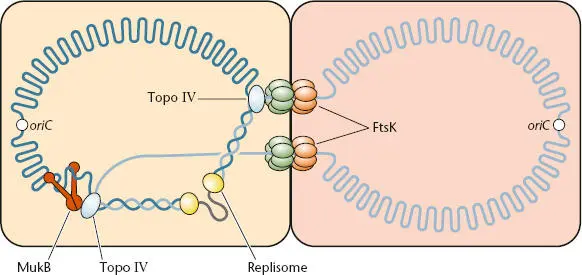
Figure 1.19 Model of the way in which chromosome decatenation by topoisomerase IV (Topo IV) is coordinated with chromosome condensation by MukB and chromosome translocation with FtsK. The two daughter chromosomes that have been replicated are indicated by light and dark blue lines, and the unreplicated portion of the chromosome is shown in gray. Unwinding of the template DNA strands that is associated with DNA replication twists the newly replicated strands of DNA, forming precatenanes that go on to become catenanes if not unlinked by the action of Topo IV. Topo IV can interact with the chromosome condensation protein MukB to remove catenanes before DNA is condensed. Topo IV also interacts with the FtsK translocase to coordinate decatenation with chromosome segregation. The replisome is shown as a yellow circle, and double-stranded DNA is shown as a single line for simplicity.
Читать дальше
